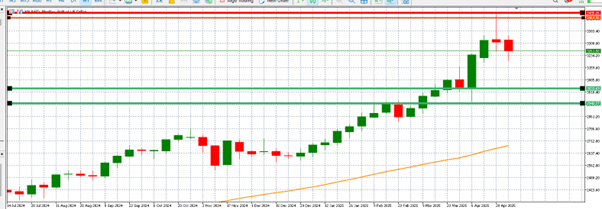Introduction.
The gold prices are currently facing bearish pressure due to the release of important economic data in America. After a strong positive run in previous weeks, gold has lost more of its shine this this week and is trading around $3,278 an ounce at this writing. The slide followed a rally above $34,000 earlier in the previous week, fueled mostly by expectations of a dovish Fed and traiff threats. This optimism was dampened by the release of US Non-Farm Payrolls (NFP) data today.

Gold CFD trading price chart by XTB
The yellow metal has long been a safe-haven asset and has historically been sensitive to macroeconomic data, especially those coming out of America. This week saw much of the attention focusing on the NFP data, and its mixed results have encouraged speculations regarding gold's sustained momentum. Here in this article, we will discuss today’s NFP data influencing gold prices, what responses from the Federal Reserve might follow, and what traders should anticipate going into next week’s pivotal FOMC meeting.
Today’s US NFP Data and Gold Price
The Non-Farm Payrolls (NFP) release is one of the most important data releases for gold traders since it acts as a very good gauge of the health of the United States labor market and its implications for Federal Reserve monetary policy. A healthy labor market has the potential to delay or even dispel speculation about rate cuts, while a softening labor market is oftentimes used as justification for monetary easing; both have a direct bearing on gold.
Today's Non-Farm Payrolls report delivered a mixed result:
Headline NFP number: 177K jobs added (vs. 138K forecast, 185K previous)
Average hourly earnings: 0.2% (vs. 0.3% forecast and previous)
Unemployment rate: 4.2% (unchanged from forecast and previous)
While the headline payroll number beat expectations, wage growth was less than expected, and the unemployment rate did not change. The payroll figure, which beat expectations, put initial pressure on gold prices, pushing them down from intraweek highs. This followed on concerns of reduced urgency on the part of the Federal Reserve to cut interest rates, which reduced the short-term attractiveness of gold.
The initial reaction of the market was a risk-averse one towards gold, with traders rushing to lock in profits in view of its latest rally. Many are now wondering: Has gold topped in the short term? Or is this only a short-term retracement before another rise?
The Fed and US NFP
The Non-Farm Payroll (NFP) data and Federal Reserve policy are interconnected. The Federal Reserve is in a tough position today of trying to keep inflation in check without crimping economic growth. The relatively muted wage figures seen today give some room to the Federal Reserve to pursue its agenda, especially in view of wage inflation acting as a major driver of aggregate inflationary influence.
The Federal Reserve has faced increasing pressure to alter its prevailing tightening tilt. With inflation cooling and growth moderating, plenty of market players argue that the Federal Reserve has about reached its capacity to initiate rate reductions. The Non-Farm Payroll data today, while not outright soft, provides adequate cover for the Federal Reserve to consider loosening measures without seeming overly reactive.
The less strong wage growth than predicted can be a major area of discussion in future Federal Reserve communications. This would be a timely economic and political justification: "We're experiencing labor market softness and inflation risks are easing." The central bank has the framing it needs to explain a turn without giving any sense of alarm.
Potential Rate Cut and Gold If the Federal Reserve were to reduce interest rates in the near term, gold would be affected considerably. Falling interest rates reduce the opportunity cost of holding non-yielding assets like gold, leading to heightened prices in most cases. Historically, gold has performed well in times of falling interest rates since it becomes a more attractive store of value.
On the other hand, if policymakers opt against rate reductions in response to weaker wage data and moderating inflationary pressures, gold might continue to consolidate or decline. The current price action reflects this dovish stance by market players in taking a wait-and-see position until policymakers offer clear indications before taking direction trades.
In any case, the underlying situation remains supportive of a positive perspective. Central banks continue to buy gold worldwide, and geopolitical tensions between rivals continue to be present. These factors form a cornerstone for gold prices even in cases of short-term loss of momentum.
Finally, attention turns to the next FOMC meeting.
In response to today's release of NFP data, all eyes will now be firmly set on next week's FOMC meeting. This meeting is likely to be turning-point in nature since participants are keen to know if today's labor market numbers have really affected Federal Reserve policy.
A dovish note or even an intimation of a future rate reduction has the potential to revive gold's rally. But if the Federal Reserve is to affirm its dovish stance and intensify its data-oriented approach, one can expect gold to continue drifting or consolidate more. Either way, this meeting is likely to bring volatility back to the market.
For gold traders, upcoming sessions are all about positioning: to find out how the Federal Reserve is analyzing the mix of data and whether it will take this data to signal the onset of easing. Meanwhile, gold is in wait-and-see mode; but let us not confuse this with complacency.
Conclusion.
Gold's modest pullback this week is a reminder that even in bullish trends, corrections are natural. While today's NFP report didn’t deliver a knockout blow, it has introduced new questions around timing and policy direction. With the FOMC meeting now in focus, the stage is set for the next major move in gold. Investors need to be agile and well-prepared. The gold story continues to be positive; however, in the near term, all depends on the action of the Federal Reserve.
